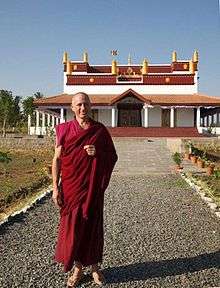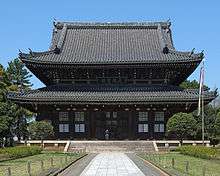Abbot (Buddhism)

In addition to its use in a Christian context, abbot is a term used in English-speaking countries for a monk who holds the position of administrator of a Buddhist monastery or large Buddhist temple.[2] In Buddhist nunneries, the nun who holds the equivalent position is known in English as the abbess.
The English word "abbot" is used instead of all the various words that exist in the languages of the countries where Buddhism is, or was historically, well established.
Responsibilities
The administrative duties of an abbot or abbess include overseeing the day-to-day running of the monastery.[2][3] The Abbot or Abbess also has spiritual responsibility for the monastics under their care, and is required to interact with the abbots or abbesses of other monasteries.[4]
Languages other than English
Asian countries where Buddhism is still widely practiced have words in their own languages for the abbot of a Buddhist monastery or large temple:
Chinese
in Chinese Chan Buddhist monasteries, one word for abbot is Fangzhang meaning "ten feet square", a reference to the size of Vimalakirti's stone room.[5] Another Chinese word for abbot is Zhuchi, meaning dweller and upholder.[6]
Japanese
In Zen Buddhism, the most commonly used Japanese words for the abbot of a large Zen temple or Zen monastery are juji[7] and choro.[2]
Tibetan
The abbot of a Tibetan Buddhist monastery is known as the Khenpo. This means "the one who gives the monks vows". The abbot is addressed as, and referred to, as "Khen Rinpoche". Another word used for more senior abbots is Khenchen, which means senior khenpo.[8]
Korean
The Korean word for abbot is chuji.[3][5]
References
- ↑ Taylor, Ella (November 20, 2014). "A Frustrating Love Letter In 'Monk With A Camera'". NPR. Retrieved April 5, 2015.
- ↑ 2.0 2.1 2.2 Baroni, Helen Josephine (2002). The illustrated Encyclopedia of Zen Buddhism. Rosen Publishing. p. 1. ISBN 9780823922406.
- ↑ 3.0 3.1 Buswell, Robert E. (1993). The Zen Monastic Experience: Buddhist Practice in Contemporary Korea. Princeton University Press. p. 110. ISBN 9780691034775.
- ↑ Lawton, Kim (June 15, 2012). "Buddhist Abbot Nicholas Vreeland". PBS. Retrieved April 5, 2015.
- ↑ 5.0 5.1 Buswell Jr., Robert E.; Lopez Jr., Donald S. (2013). The Princeton Dictionary of Buddhism. Princeton University Press. p. 295. ISBN 9781400848058.
- ↑ "Buddhism A to Z: A entries". Buddhist Text Translation Society. Retrieved April 5, 2015.
- ↑ "abbot (jūjishoku 住持職, jūji 住持, jūshoku 住職)". Sōtō Zen International. Retrieved April 5, 2015.
- ↑ "Shamar Rinpoche's explanation of the proper use of the titles "Khenchen" and "Khenpo"". Bodhi Path Buddhist Center. Retrieved April 5, 2015.
